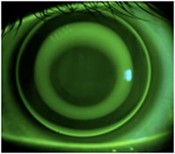


Myopia, also known as nearsightedness, is an eye condition where objects at a distance appear blurry and out of focus and objects up close are clear. Myopia is caused by the eyeball growing too long causing the image not to focus on the retina. Excessive corneal curvature can also cause myopia. Generally, myopia develops during childhood when the eye is going through periods of rapid growth. The growth may continue to progress quickly until early adulthood when the eye tends to stabilize and change slowly.
Nearsightedness has increased exponentially over the last twenty years. In some countries, such as China, over 80% of the population is nearsighted. In the United States, myopia has increased 65% in the last thirty years. Now 42% of people in the United States aged 12-54 are myopic, and that number is increasing at an alarming rate, especially among school-age children. It is estimated that about 25% of the world are myopic and that number is expected to grow 50% by 2050.
Our population is increasingly becoming more nearsighted. A combination of factors such as culture, diet, and genetics have been documented to influence the growth rate of myopia. Eye fatigue from increasing amounts of close-up work with computers, phones, tablets, reading and studying are factors in contributing to the growing incidence of myopia. Also, less time is spent outdoors which contribute to the increase in myopia. More time is spent looking at objects closer to our faces and less time focusing on objects far away.
Low amounts of nearsightedness can make your vision blurry, but higher amounts of nearsightedness can increase the risk of developing:
Schedule an appointment today to see if your child is at risk!
Myopia Control is the practice of implementing professional techniques to help slow the progression of myopia. Myopia Control is for parents of children who agree that progressive myopia is more than a vision problem, but rather a real disease. Myopia Control is not to be taken lightly. Our Myopia Control programs require a vested interest to ensure compliance. They take time, financial investment and patience.
We understand that every patient is different therefore we offer several different treatment options that are customized to you and your unique needs. The doctor carefully monitors each myopia management case. Myopia management treatments may include:
Orthokeratology, also known as Ortho-K, is a method where specially designed contact lenses are used to temporarily reshape the cornea while sleeping to improve the vision. The lenses are worn while asleep and removed upon waking in the morning. Gentle molding changes that occur overnight change the shape of the cornea so that light rays not only focus onto the center of the retina, called the fovea, but also focus onto the peripheral retina. For most Ortho-K patients, the effect causes close to 20/20 vision all day long until night, when the lenses must be worn again. The child can have 20/20 uncorrected vision using no glasses or contact lenses all day long. Studies show that it is an effective way to reduce myopia progression.
Atropine is a prescribed eye drop used previously in eye care for treatment of inflammation and for relaxing the focusing muscle for a more accurate exam in children. The exact mechanism is unclear, but researches
feel that atropine may cause a change in the biochemical mechanisms involved in regulation of elongation of the eye. Low dose atropine is instilled nightly anywhere from a few months to two years. Atropine therapy has shown promise in reducing the progression of myopia. However, some doctors are conservative when prescribing it because atropine can have some side effects such as redness or itchiness around the eye.
*MiSight 1 day® contact lens is the only FDA approved soft contact lens indicated to slow the progression of myopia (nearsightedness) in children, aged 8-12 at the initiation of treatment. Slowing of myopia progression is expected but not guaranteed. We are excited to journey together with your family in this program now and into the future.
Medical insurance or vision plans may cover a basic eye examination which is around $150. However, neither covers myopia control programs. If your child is a candidate for myopia control, we will first decide which program is better for your child. Then, the myopia program and costs which begin at only $1500 will be fully discussed during the consultation. We are committed to be available along this journey and we ask for your commitment to the follow up appointments and lens wear expectations.
Give us a call 352-293-2183 to schedule a consultation today!


